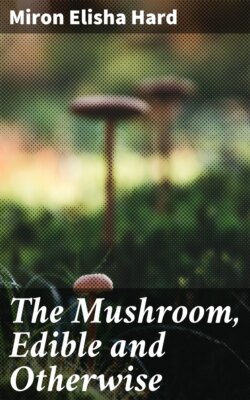Читать книгу The Mushroom, Edible and Otherwise - Miron Elisha Hard - Страница 18
На сайте Литреса книга снята с продажи.
Amanita phalloides. Fr.
ОглавлениеTable of Contents
The Deadly Amanita.
Figure 11.—Amanita phalloides. Fr. Showing volva at the base, cap dark.
Figure 12.—Amanita phalloides. Fr. White form showing volva, scaly stem, ring.
Phalloides means phallus-like. This plant and its related species are deadly poisonous. For this reason the plant should be carefully studied and thoroughly known by every mushroom hunter. In different localities, and sometimes in the same locality, the plant will appear in very different shades of color. There are also variations in the way in which the volva is ruptured, as well as in the character of the stem.
The beginner will imagine he has a new species often, till he becomes thoroughly acquainted with all the idiosyncrasies of this plant.
The pileus is smooth, even, viscid when young and moist, frequently adorned with a few fragments of the volva, white, grayish white, sometimes smoky-brown; whether the pileus be white, oyster-color or smoky-brown, the center of the cap will be several shades darker than the margin. The plant changes from a knob or egg-shape when young, to almost flat when fully expanded. Many plants have a marked umbo on the top of the cap and the rim of the cap may be slightly turned up.
The gills are always white, wide, ventricose, rounded next to the stem, and free from it.
The stem is smooth, white unless in cases where the cap is dark, then the stem of those plants are apt to be of the same color, tapering upward as in the specimen (Fig. 11); stuffed, then hollow, inclined to discolor when handled.
The volva of this species is quite variable and more or less buried in the ground, where careful observation will reveal it.
One need never confound this species with the meadow mushroom, for the spores of that are always purple-brown, while a spore-print of this will always reveal white spores. I have seen a slight tint of pink in the gills of the A. phalloides but the spores were always white. Until one knows thoroughly both Lepiota naucina and A. phalloides before eating the former he should always hunt carefully for the remains of a volva and a bulbous base in the soil.
This plant is quite conspicuous and inviting in all of its various shades of color. It is found in woods, and along the margin of woods, and sometimes on lawns. It is from four to eight inches high and the pileus from three to five inches broad. There is a personality about the plant that renders it readily recognizable after it has once been learned. Found from August to October.
